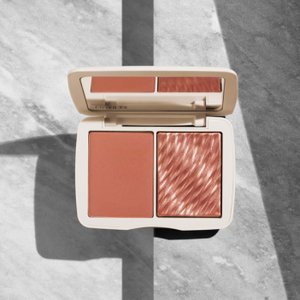
Makeup Breakdown: 5 Techniques to Know Now
Strobing. Stippling. Buffing.
Words like these are all over YouTube tutorials and magazine how-tos, and TikTok videos. But what do those technical makeup terms really mean—and why do they matter to your beauty goals?
Scroll through our guide to learn how these terms and techniques can enhance your unique personal style—or click the links below to get fast facts on every essential beauty term.
What is "Baking" Your Makeup?
In makeup, "baking" is a technique for budge-proof foundation, concealer, contour, and highlight. It's called "baking" because it uses the skin's natural warmth to "bake" setting powder into base makeup, making it stay put for a very long time.
Baking is also a way to help added color, like eyeshadow, lay down evenly and firmly on skin. The technique was first pioneered in drag and burlesque communities, and sometimes the pros do an extreme version with strong lights—or even a blow dryer—to add extra heat.
The benefits of baking are stay-put makeup, an even skin tone, and better visibility on high-definition formats like digital video. (That's why TikTok loves it so much) But without practice, the right moisturizer and a quality setting powder that blends easily, baking can leave a cakey finish and even dry out skin.
For a great bake, use a nourishing product like Skin Discovered Longwear Concealer on your skin's more sensitive areas (under the eyes, above the bow of the lip). Then dust a thin, even layer of Perfect Setting Powder for an incredibly translucent, long-lasting finish.
What is "Blending" Your Makeup?
In makeup, “blending” is a technique that makes different colors and textures look seamless, and even flawless.
Think you already know about blending? Maybe... but here are some pro tips that often fly under the radar. First, blending happens best on a smooth surface—and natural skin, however beautiful, is still a porous and uneven canvas. Use a Makeup Primer to protect, nourish, and prepare skin for makeup, and you’ll have the best possible beginning for wow-worthy makeup.
Blending is also easier when you’re using buildable product—the kind that can be applied in layers, which add more natural transitions in color and shine. That’s especially true for contouring and strobing, when shadows and light should seem totally flawless. For strobing, our Custom Enhancer Drops were designed to be layered onto skin for subtle glow or high-impact glamour.
It goes without saying that great brushes blend product with more smoothness and consistency. Life is hard enough—blending should be easy.
What is "Buffing" Your Makeup?
In makeup, “buffing” is a technique that blends and smooths foundation by brushing product onto the skin in small, soft circles.
Buffing is easy, and it stimulates blood flow and oxygen in skin cells, which increases radiance and firmness while helping reduce puffiness and redness. To do it, dip a Custom Application Brush lightly into your foundation of choice. Apply in small, soft circles across your entire face, and repeat as necessary.
Buffing relies on layering, so use a light hand at first, and build up coverage as desired. And remember, it’s always easier to apply more makeup than to take some away.
What is "Stippling" Your Makeup?
In makeup, “stippling” is a technique that covers imperfections in skin texture or skin tone. It works by applying liquid foundation on your face in tiny dots, then blending them together for a super-smooth, almost-filtered effect.
Stippling is the extra-strength version of buffing, and it requires a pro-level Custom Application Brush to apply, blend, and smooth your foundation in a seriously even way.
First, apply foundation to the side of your hand, then gently dip the brush—just the tips of the brush bristles—into the product. Dot your face with the brush until skin is covered in tiny blips of foundation. (Think Van Gogh, but with both ears.) Next, brush gently—again, using just the tip of the bristles—in small circles to blend the foundation, repeating as necessary until you’ve got full coverage.
You can use any liquid or cream foundation to stipple—just not powder. And all finishes work with this technique, whether they’re modern matte, silky and natural, or creamy and highly pigmented.
One piece of advice from the masters: stipple in the best lighting possible to ensure full, even coverage.
What is "Strobing" Your Makeup?
In makeup, “strobing” is a technique that layers and reflects light onto your best features, adding an otherworldly glow without oily shine.
How is strobing different from contouring? It eliminates the darker shades used for sharp, strong cheekbones and deep-set eyes, using only highlight for a softer, more ethereal look.
Strobing is simple with the right tools, like Custom Enhancer Drops. To ensure strobing looks glowy instead of oily, stick with key areas of the face: the tops of your cheekbones, the bow of your lips, and the outer corner of your eyes.
With fingers or a soft, small brush, apply a small amount of your chosen product (no more than three drops—this stuff goes a long way), blend well, and that’s it. Seriously.











